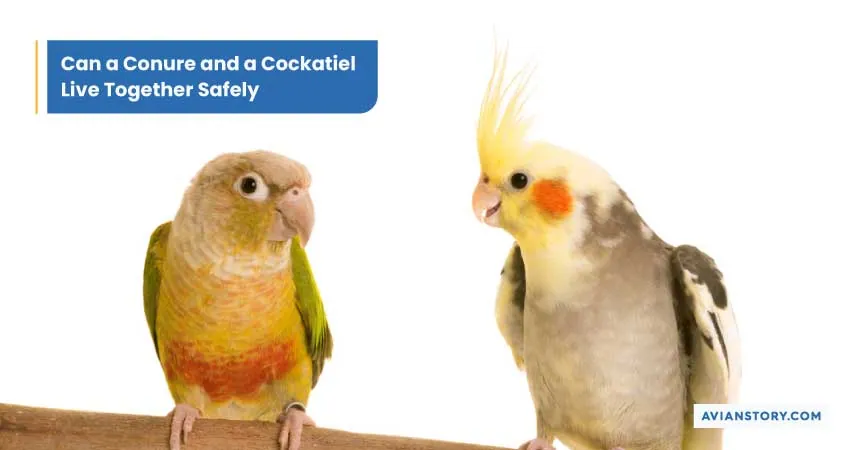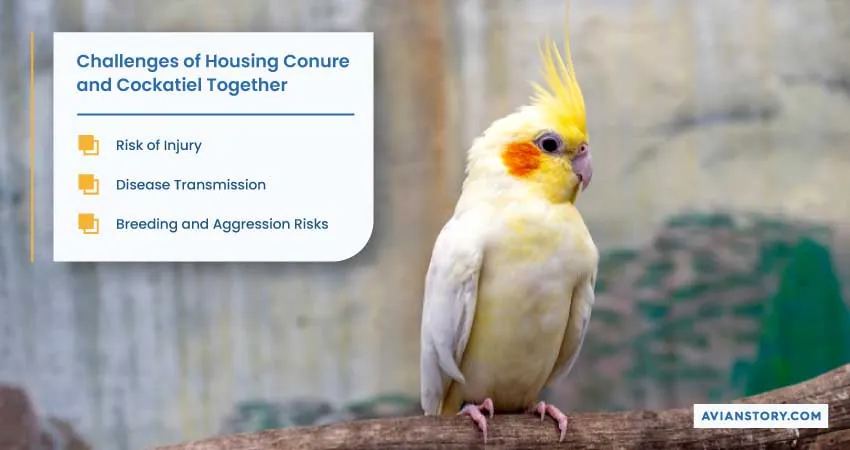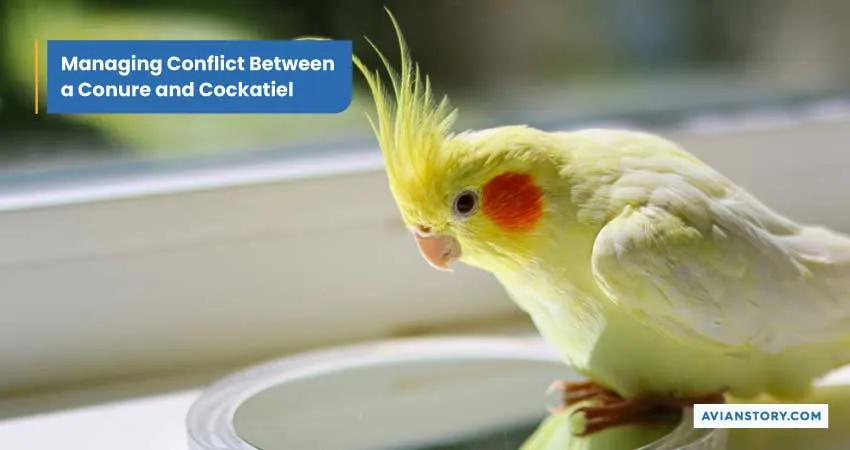Can Conure and Cockatiel Live Together? A Complete Explanation!
Conures and cockatiels belong to the same order but in different families. You will see them share some character traits. But differences are also prominent in many areas. So, many bird owners get confused about keeping these two birds together.
Can conure and cockatiel live together? There is no concrete answer to this question. Conures and cockatiels can end up making a friendly pair if you introduce them correctly and consider all other aspects. Otherwise, some birds can be aggressive and harm others.
You should read this detailed guide to learn about their characteristics, behavioral patterns, activities, cage requirements, and more. Let’s get into it.
Can a Conure and a Cockatiel Live Together Safely?

Answering this question with a straight yes or no is arduous. This is because conures and cockatiels have some common traits, but that doesn’t guarantee peaceful cohabitation. So the question arises: Can conure and cockatiel live together?
If you introduce these birds slowly, depending on their personalities and requirements, they might live together safely. Otherwise, the chance of a fight breaking out between these birds is high.
Factors Affecting Cohabitation of Conures and Cockatiels
You should remember the following factors before putting these birds together.
- Some conure species are larger than cockatiels. As a result, they can be more territorial than cockatiels and show aggression.
- Cockatiels are less vocal than conures and have a melodious tone. But conures screech loudly, which can be a problem for cockatiels.
- Conures want more attention from their human companions. But cockatiels are more timid and don’t like frequent handling.
- Larger conure species need more cage space than cockatiels. So, putting them together into a small cage can induce fights. You might want to know the correct cage size for cockatiel. I will get onto that in a bit.
- Conures are high-perching birds, whereas cockatiels are ground-foraging. So, the necessary accessories should be inside the cage for both birds. And if a lot of accessories are inside the cage, it can create a mess.
Common Concerns and Misconceptions
The most common misconception about the cohabitation of conures and cockatiels is these birds can easily live together because they belong to the same order. But that can’t be far from the truth. These birds must be introduced in an amicable way.
How Do the Personality Traits of Conures and Cockatiels Compare?
Conures and cockatiels have distinctive personality traits that can sometimes conflict.

Natural Behavior of Conures and Cockatiels
In the wild, these birds are pretty active and vocal. Conures are native to South America. These birds tend to perch high on trees, so they need that in captivity as well. On the other hand, cockatiels are native to Australia, and they are ground-foraging birds.
It means cockatiels find their food on the ground. These birds can do shallow digging in the wild to be comfortable while resting. Cockatiels are also moderately active in the wild.
How Do Their Personalities Impact Cohabitation?
As a more dominant species, conures will be more territorial and aggressive. So, they might start bullying the cockatiel. Fights can also occur in some cases. Jealousy is another common personality trait in both birds. Bringing a new bird home can make the previous one jealous.
Real Cohabitation Stories
Naema Bhatti is a bird owner who has kept conures and cockatiels together. In her case, the birds are pretty calm and compassionate. They enjoy playing together. You can watch them playing on Naema Bhatti’s YouTube channel.
What Are the Essential Needs of Both Conures and Cockatiels?
Before putting these birds together, you should consider their essential needs to ensure amicable cohabitation.

Space Requirements
The essential space inside the cage will depend on the species and the number of birds. In general, conures need a cage of 24 x 24 x 24 inches at a minimum. For cockatiels, the minimum space requirement is 20 x 20 x 24 inches.
But if you have multiple conures and cockatiels, you should multiply the space requirement by the number of birds.
Dietary Patterns
Despite minor differences, a big part of their diet overlap. So, they can share some common food like vegetables, small seeds, etc. But conures will love leafy greens more, whereas cockatiels love fruits. Food bowls should be separate for each bird.
You can offer vegetables, fruits, and seeds to both birds. But don’t forget to add some extra leafy greens to the conure bowl. And provide plenty of fresh water for each bird.
Sleep and Activity Patterns
As birds from the parrot family, conures and cockatiels share sleeping and activity patterns. Both birds need at least 10-12 hours of sleep every day to be energetic and healthy.
But they don’t have continuous sleep patterns like us. Instead, they sleep in small rounds. Both birds are diurnal, so they will remain active during the day. As their activity patterns are similar, they won’t cause disturbance while the other bird is sleeping. So you can keep them together.
Maintaining regular sleep routines for both birds can help further.
What Potential Challenges Might Arise When Housing a Conure and Cockatiel Together?

Bird owners should be very careful while housing conures and cockatiels together for the following reasons.
Risk of Injury
Cockatiels can be longer than conures, but some conure species are larger and stronger. They also have a larger beak than cockatiels. If the birds start fighting, it is probable that the cockatiel will get badly injured.
Disease Transmission
When one of the birds inside the cage is sick, diseases can be transmitted to cagemates. According to the MSD Veterinary Manual, the transmission of various diseases is possible between these birds. For example, avian gastric yeast, avian bornavirus, psittacine herpesvirus, and gastrointestinal parasites can be transmitted from one bird to another.
Breeding and Aggression Risks
Genetic differences are too prominent between these two birds. So, their breeding can lead to mutation or health problems. Also, conures can become aggressive and hurt cockatiels. Male cockatiels are sometimes seen to be aggressive as well.
How Should the Cage Environment Be Adapted for Both Birds?

To make an aviary suitable for conures and cockatiels, you should focus on the following factors.
Cage Size and Design
I have already mentioned the cage size for both birds. Make sure the birds are getting as much space as possible, which will reduce territoriality. Learn more about cockatiel cage setups to ensure they feel safe and comfortable with conures.
Toy and Perch Placement
As you might already know, conures love high perches. So, you should place enough elevated perches for them to rest. Conures are very playful, so you must provide them with a variety of toys.
Cockatiels don’t need high perches because they forage on the ground. But you should provide swinging, foraging, or chewing toys for a cockatiel to keep it healthy and happy.
Food and Water Arrangements
Food and water dishes should always be separate for each bird. If you don’t provide enough food and water dishes, birds can become aggressive and start fighting.
How Should a Conure and Cockatiel Be Introduced to Each Other?

The introduction of these two birds should be slow and gentle. And you should carefully monitor them in the introductory phase.
Steps for Introduction
- Make sure the birds are quarantined for at least 45 days before introducing them to each other.
- Start the introduction on neutral ground. Take both birds out of their cages and let them be close to each other within the room. Don’t let one bird enter the other bird’s cage.
- Keep the first few sessions short. Increase their time together gradually.
- Once they are fully aware of the companionship, put them in a large aviary.
How to Tell If the Birds Are Stressed?
The first sign of stress is puffed feathers. Also, they can start hissing at each other if they don’t feel comfortable. Loud chattering can also indicate that the birds aren’t compatible. In some cases, conures can start biting cockatiels.
What If the Birds Aren’t Compatible?
If the interaction between conures and cockatiels doesn’t seem peaceful, you should no longer keep them together. Put them back into their respective cages and move the cages apart.
What Are Effective Strategies for Managing Conflict Between a Conure and Cockatiel?

Understanding the conflict between birds is crucial for effective management. Look out for the following signs.
- One of the birds might be bullying the other through vocalization.
- Birds biting each other or vigorously plucking feathers.
- Preventing the other bird from eating or drinking.
How to De-escalate Tension?
If you notice signs of conflict or tension in the birds, you should immediately separate the birds. Don’t let them play together, and keep them in their separate cages. You can also give them some treats to tame.
For example, if any tense situation arises, use gentle vocalization. Offer them treats if they show positive behavior.
What Precautions Should Be Taken If a Conure and Cockatiel Show Signs of Breeding?
Though crossbreeding is possible in parrots, it isn’t common between conures and cockatiels. Due to the genetic disparity, the chance of getting a hybrid offspring from conures and cockatiels is really low.
What Can You Do to Prevent Crossbreeding?
When living together in a cage, conures and cockatiels can show signs of breeding. For example, they can start lifting their tails. Discourage such behaviors and separate the birds if you see signs of breeding.
You can also put them to bed earlier to prevent crossbreeding. It makes the birds feel that the season isn’t suitable for breeding. Giving hormone injections may also help prevent breeding.
How to Manage Hybrid Offspring?
Even if conures and cockatiels breed, the offspring may show mutations and serious health problems. You should contact an experienced veterinarian to handle the situation.
Once conures and cockatiels are introduced properly, they can share playtime outside the cage. But you need to take the following safety measures.
- Keep them in an enclosed space so that they can’t fly away.
- Let them play together under strict supervision so that they don’t start fighting.
- Don’t keep anything around them that can hurt the birds while playing.
- Give treats to the birds when they behave well to encourage positive interactions.
What Other Birds Are Suitable As Companions?
When conures and cockatiels don’t get along, you may think of bringing other birds, like budgies or lovebirds, as companions. Before you do that, ask yourself, can cockatiels and budgies live together? If they can, you should go through a careful introduction.
Conclusion: Making an Informed Decision on Conure and Cockatiel Cohabitation
The above discussion makes it clear that conures and cockatiels can live together despite their disparity in many cases. However, they should be introduced gradually and monitored continuously for signs of risks.
For a successful cohabitation, these birds should have enough space, separate food and water dishes, and play toys inside the cage. Encouraging positive behavior through training and treats can improve the overall well-being of conures and cockatiels.
